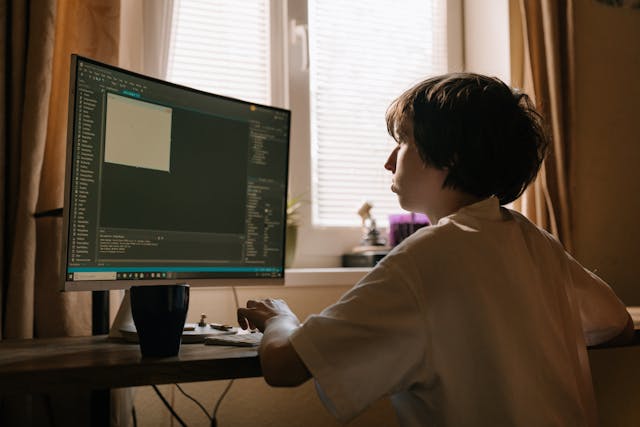
What Is Coding For Kids?
In today’s world, education alone is not enough. Education, in conjunction with digital competence and other essential skills, paves the way for a bright and successful future. Considering this, CBSE schools initiated skill-based education and are now teaching coding to kids along with many other skill subjects.
If you are wondering what is coding for kids, let us give you a brief context.
In April 2020, CBSE (Central Board of Secondary Education) introduced the country to skill-based education. This initiative marked the transformation of the Indian education system.
It aims at metamorphosing educational institutions into a dynamic learning ecosystem and imparting several essential skills to students to make them confident, self-reliant, and ready for the tough world outside the school.
Coding is one of the many skill-based subjects that are now a part of the CBSE curriculum for upper primary, secondary, and higher secondary levels. In this article, we will tell you what is coding for students, what its benefits are, and how to teach coding to kids.
What is coding classes for students?
Coding for school students is a program that teaches them to create and operate computer programs with the help of age-appropriate programming tools and languages. Students learn to build websites, create games, and develop apps through languages like JavaScript or Python.
The program, under CBSE skill subject initiatives, takes a systematized approach in helping little kids learn coding in a simplified and interesting manner. They start with easy-to-learn and fascinating visual programming platforms to understand fundamental coding concepts and then gradually move to more complicated components like text-based languages.
Coding isn’t just about learning a new technological skill. It also promotes essential skills like creativity, imagination, problem-solving, algorithmic thinking, and persistence.
Benefits of coding for kids
Here are the benefits of teaching coding to kids-
It instills computational and logical problem-solving skills
When children code, they approach a problem in a planned and systematic manner by breaking it down and solving it in steps. This instills computational and problem-solving skills in children at a very early age.
These skills help children in their lives, too. They learn to face problems and find logical solutions by analyzing and breaking them into smaller, manageable steps.
It fosters creativity
Coding is an active form of learning. When kids create code, they work on translating their ideas and imaginations into a reality. The process involves imagination, experiments, critical thinking, and problem-solving. They constantly work their creative muscles, harbor skepticism, get stuck, look for solutions, explore new possibilities, try, fail, and try again. All these things strengthen their ability to create something new without fearing failure. They become unapologetic about thinking and trying something completely out of the box. It helps in fostering creativity.
It encourages structural thinking
Coding involves identifying the role of small components, understanding the pattern, and using the components to create something big. It encourages structural thinking.
Whether it is a text-based language or a visual program, it teaches students to envision patterns in smaller components and construct something complex. It also fuels their imagination.
It promotes analytical thinking and problem-solving
Coding is not an easy task. Beginners and even experienced programmers face certain challenges, such as debugging errors, executing new functions, etc. Overcoming these roadblocks requires analytical thinking and problem-solving skills.
When kids code, they encounter many problems and spend time analyzing them, trying to understand their basis, and looking for different ways to solve the issues. This approach helps in enhancing their critical thinking and problem-solving skills.
It enhances academic performance
What children learn from coding extends far beyond the computer screen and keyboard. By learning coding, they pick up skills like critical thinking, problem-solving, and persistence that help them in other disciplines.
Mathematics requires logical reasoning, algorithms, and pattern-identifying skills. Science requires systematic thinking and experimentation. Social studies requires analyzing data. Arts and design require imagination and storytelling. Coding equips children with all these skills that help them improve their overall academic performance.
It teaches resilience and persistence
Coding doesn’t come easy. It requires patience and persistence. When children code, they encounter failure, not once but several times. It helps them understand that achieving something requires constant effort and a never-say-die attitude.
How to teach coding to kids?
Now that you know the benefits of coding, let us share with you some approaches to teaching coding to your kids.
Here they are-
Watch online tutorials
Online tutorials are another way of teaching coding to students. YouTube, Google, and other platforms offer several pre-recorded tutorials on coding for school students.
However, these resources are not as effective as coding classes for kids because they are not personalized and interactive.
Join coding classes
Here, do not confuse coding classes with coding skill modules/subjects. Let us start by telling you what is coding classes?
These are online and offline classes that take a structured approach to teaching coding to young minds. With expert guidance, hands-on projects, and interactive learning sessions, children grasp the fundamentals of coding in a much better way.
A strong foundational knowledge of coding helps students create a solid career in fields like software development, data science, web development, etc.
Rely on CBSE schools
As mentioned, CBSE schools offer well-curated programs in coding for kids. They acquire a hands-on approach to introduce students to the interesting world of coding.
Top CBSE schools, including DWPS Barasat, have specialized coding modules and subjects to prepare students for a career in engineering, web development, cybersecurity, and other related fields.
The bottom line
Skill education is not an option in the modern technology-driven world. Exposing your child to coding in their formative years helps in building a strong career while imparting valuable skills applicable in real life.
Your role as a parent is to help your kid explore their passions and interests. Encourage them to read programming books to gain core knowledge of coding and build projects to test the practical application of what they are learning.
The school will take care of the rest.







